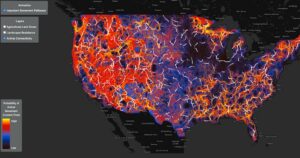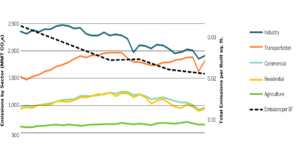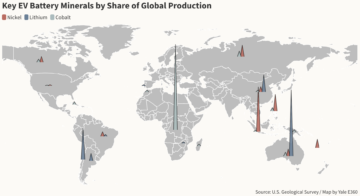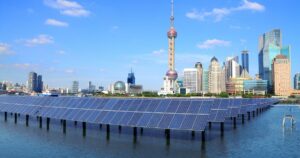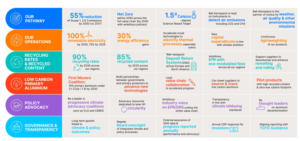
More than one in 10 urban areas scored by the world’s leading environmental disclosure platform have received its highest possible “A” rating last week, highlighting how leading cities are embedding climate action across their operations.
Of the 939 cities reporting through the CDP platform and ranked in its sixth annual Cities A List, 119 were cited as leaders in environmental action and transparency for 2023 — with top ranking authorities boasting up to four times as many mitigation and adaptation actions as non-A List cities.
CDP’s analysis also reported rising renewable energy use from a number of cities, with the likes of Trondheim in Norway, Ecuador’s capital Quito and San Francisco reporting that renewable energy covers the vast majority of their power consumption.
While the USA has the most “A List” cities of any one country — featuring 35 urban centers from Los Angeles to Philadelphia on the list — the number of U.K. city authorities securing the top rating also rose from 19 in 2022 to 26 in 2023. Birmingham, Brighton & Hove, and Cambridge joined the likes of London, Manchester, York and Sunderland on the list for the first time.
While Europe boasts the largest share of ‘A List’ cities followed by North America, this year’s report also revealed significant progress from cities in the Global South.
While Europe boasts the largest share of “A List” cities followed by North America, this year’s report also revealed significant progress from cities in the Global South.
According to CDP, 40 percent — or 47 cities — made their first appearance on the list this year, with Istanbul, Jakarta, Bogotá and Can Tho in Vietnam all receiving their first “A” grade. Moreover, Brazil, Colombia, The Philippines and Turkey all received their highest number of “A” rated cities to date.
The progress comes after recent CDP data found that 80 percent of cities face climate hazards such as heatwaves and floods, with 70 percent expecting them to become more intense in the coming years.
Maia Kutner, CDP director of cities, states and regions, reflected that 2023 will be remembered as the year when centuries-long climate records were not just broken, but smashed.
“While cities around the world felt the full force of the year’s climate disasters, from heatwaves to floods, it’s positive that many are leading by example in tackling climate change with tangible action,” she said. “Today, we are delighted to celebrate the 119 cities, from Lima to London, whose effective action make them global climate leaders. Even more encouragingly, this is not the first time that many — including from the Global South — are on CDP’s A List, showing that serious climate action is now mainstream for many of the world’s cities.
It’s positive that many are leading by example in tackling climate change with tangible action.
However, Kutner warned more action was needed from city leaders to accelerate the net zero transition and prepare their regions for escalating climate impacts. “This is no time for complacency, though,” he said. “Cities not reporting environmental data must step up their transparency, while many more need to accelerate their efforts to reach net zero and create a more sustainable future for all, especially the most vulnerable.”
Among a number of examples of urban innovation in climate mitigation and adaptation, CDP flagged U.K.-based measures such as a digital twin of London’s “Square Mile” created to determine the areas most vulnerable to heat stress and flooding impacts.
It also highlighted how authorities in Sunderland are installing living roofs on 90 bus shelters across the city to enhance local biodiversity. Nicknamed “Bee Bus Stops,” they sit on top of shelters made from recycled materials and are planted with a mix of native wildflower species to support bees and other pollinators.
The living roofs also help provide natural cooling to counteract the effects of “urban heat islands,” absorb rainwater to alleviate flooding and filter fine dust particles from the air.
- SEO Powered Content & PR Distribution. Get Amplified Today.
- PlatoData.Network Vertical Generative Ai. Empower Yourself. Access Here.
- PlatoAiStream. Web3 Intelligence. Knowledge Amplified. Access Here.
- PlatoESG. Carbon, CleanTech, Energy, Environment, Solar, Waste Management. Access Here.
- PlatoHealth. Biotech and Clinical Trials Intelligence. Access Here.
- Source: https://www.greenbiz.com/article/cdp-ranks-list-cities-transparency-and-climate-performance
- :has
- :is
- :not
- $UP
- 10
- 19
- 2022
- 2023
- 26
- 35%
- 40
- 7
- 70
- 80
- 90
- a
- accelerate
- across
- Action
- actions
- adaptation
- After
- AIR
- All
- alleviate
- also
- america
- analysis
- and
- Angeles
- annual
- any
- ARE
- areas
- around
- AS
- Authorities
- BE
- become
- Bees
- Birmingham
- boasting
- boasts
- Brazil
- Broken
- bus
- but
- by
- cambridge
- CAN
- capital
- celebrate
- Centers
- change
- cited
- Cities
- City
- Climate
- climate action
- Climate change
- Colombia
- comes
- coming
- consumption
- counteract
- country
- covers
- create
- created
- data
- Date
- delighted
- Determine
- digital
- digital twin
- Director
- disasters
- disclosure
- Dust
- Ecuador
- Effective
- effects
- efforts
- embedding
- energy
- energy use
- enhance
- environmental
- especially
- Ether (ETH)
- Europe
- Even
- example
- examples
- expecting
- Face
- Featuring
- felt
- filter
- fine
- First
- first time
- flagged
- followed
- For
- Force
- found
- four
- Francisco
- from
- full
- future
- Global
- grade
- Have
- he
- help
- highest
- Highlighted
- highlighting
- How
- HTTPS
- Impacts
- in
- Including
- Innovation
- installing
- Islands
- Istanbul
- IT
- ITS
- joined
- just
- largest
- Last
- leaders
- leading
- likes
- List
- living
- local
- London
- los
- Los Angeles
- made
- Mainstream
- Majority
- make
- manchester
- many
- materials
- measures
- mitigation
- mix
- more
- Moreover
- most
- must
- native
- Natural
- Need
- needed
- net
- no
- North
- north america
- Norway
- now
- number
- of
- on
- ONE
- Operations
- or
- Other
- percent
- performance
- philadelphia
- Philippines
- platform
- plato
- Plato Data Intelligence
- PlatoData
- positive
- possible
- power
- Prepare
- Progress
- provide
- ranked
- Ranking
- ranks
- rated
- rating
- reach
- received
- receiving
- records
- recycled
- reflected
- regions
- Renewable
- renewable energy
- report
- Reported
- Reporting
- Revealed
- rising
- ROSE
- s
- Said
- San
- San Francisco
- securing
- serious
- Share
- she
- shelters
- showing
- significant
- sit
- sixth
- South
- square
- States
- Step
- Stops
- stress
- such
- support
- sustainable
- sustainable future
- tackling
- tangible
- than
- that
- The
- The Philippines
- the world
- their
- Them
- they
- this
- this year
- though?
- Through
- time
- times
- to
- today
- top
- transition
- Transparency
- Turkey
- twin
- U.K.
- urban
- Urban Areas
- USA
- use
- Vast
- Vietnam
- Vulnerable
- was
- we
- week
- were
- when
- while
- whose
- will
- with
- world
- year
- years
- york
- zephyrnet
- zero

